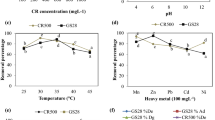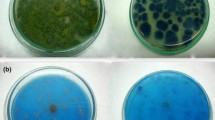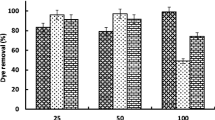Abstract
The fungal strain A. niger SA1 isolated from textile wastewater pond proved to be an important source of remediation (decolorization/degradation) for textile dye, AR 151 (Reactive diazo dye) under different physicochemical conditions. Decolorization assays of AR 151 were carried out in Simulated textile effluent under shake flask condition for 8 days. Decolorization (at 20 mg l−1 of dye) and related biomass production overall decreased with increase in pH from 5 to 9, at 30°C. It was maximum (95.71%) at pH 5 with highest amount of three residual products (36.91 (α-naphthol = 5.72) (sulfanilic acid = 24.81) (aniline = 6.38)) besides 2.05 mg ml−1 of biomass production at an optimum concentration 6 and 0.1 mg l−1 of glucose and urea respectively. The formation of the three products followed a quite different pattern at different pH values, however, it was considerably low (Total = 2.81 mg l−1) compared to the amount of decolorization (67.26%) at pH 8. Decolorization (95–97%) was most favored under mesophilic temperature (25–45°C). It increased i.e., 90–98% with subsequent increase in dye from 10 to 100 mg l−1, kept ≥50% below 400 mg l−1 and drastically declined to 17% at 500 mg l−1 of dye. Apparently, decolorization is found to be associated with fungal growth and hyphal uptake mechanism (Biosorption/Bioadsorption), however, mineralization of AR 151 and related products under different operational conditions also suggested a metabolically mediated decolorization/degradation.








Similar content being viewed by others
References
Aksu Z, Tezer S (2000) Equilibrium and kinetic modelling of biosorption of Remazol Black B by Rhizopus arrhizus in a batch system: effect of temperature. Process Biochem 36:431–439
Aksu Z, Calik A, Dursun AY et al (1999) Biosorption of iron(III)-cyanide complex anions to Rhizopus arrhizus: application of adsorption isotherms. Process Biochem 34:483–491
Alexander M (1994) Biodegradation and bioremediation. Academic Press, San Diego, 56 pp
Arora DS, Chander M (2004) Decolorization of diverse industrial dyes by some Phlebia spp and their comparison with Phanerochaete chrysosporium. J Basic Microbiol 44(5):331–338
Balan DSC, Monterio RTR (2001) Decolorization of textile dye indigo by lignolytic fungi. J Biotechnol 89:141–145
Baldrian P (2004) Purification and characterization of laccase from the white-rot fungus Daedalea quercina and decolorization of synthetic dyes by the enzyme. Appl Microbiol Biotechnol 63(5):560–563
Belsare DK, Prasad DY (1988) Decolorization of effluent from the bagasse based pulp mills by white rot fungus Schizophyllum commune. Appl Microbiol Biotechnol 28:301–304
Conatao M, Corso CR (1996) Studies of adsorptive interaction between Aspergillus niger and the reactive azo dye procion blue MX-G. Eclet Quim 21:97–102
Conneely A, Smyth WF, McMullan G (1999) Metabolism of the phthalocyanine textile dye remazol turquoise blue by Phanerochaete chrysosporium. FEMS Microbiol Lett 179:333–337
Dong JL, Zhang YW, Zhang RH et al (2005) Influence of culture conditions on laccase production and isozyme patterns in the white-rot fungus Trametes gallica. J Basic Microbiol 45(3):190–198
Ferreira VS, Magalhaes DB, Kling SH et al (2000) N-demethylation of methylene blue by lignin peroxidase from Phanerochaete chrysosporium: stoichiometric relation for H2O2 consumption. Appl Biochem Biotechnol 4(86):255–265
Fu YZ, Viraraghavan T (2000) Removal of a dye from aqueous solution by the fungus Aspergillus niger. Water Qual Res J Can 35:95–111
Fujita M, Era A, Ike M et al (2000) Decolorization of heat treatment liquor of waste sludge by a bioreactor using polyurethane foam immobilized white rot fungi equipped with an ultramembrane filtration unit. J Biosci Bioeng 90:387–394
Jacob CT, Azariah J, Hilda A et al (1998) Decolorization of procio Red MX-5B and colored textile effluent using Phanerochaete chrysosporium. J Environ Biol 19:259–264
Kapdan IK, Kargi F (2002) Biological decolorization of textile dyestuff containing wastewater by Coriolus versicolor in a rotating biological contactor. Enzyme Microb Technol 30:195–199
Knapp JS, Newby PS (1995) The microbiological decolorization of an industrial effluent containing a diazo-linked chromophore. Water Res 29:1807–1809
Kumar MNVR, Sridhari TR, Bhavani KD et al (1998) Trends in color removal from textile mill effluents. Colorage 40:25–34
Luangdilok W, Panswad T (2000) Effect of chemical structures of reactive dyes on color removal by an anaerobic–aerobic process. Water Sci Technol 42(3–4):377–382
Ly JD, Lawen A (2003) Transplasma membrane electron transport: enzymes involved and biological function. Redox Rep 8:3–21
Mansur M, Arias ME, Copa-Patino JL et al (2003) The white-rot fungus Pleurotus ostreatus secretes laccase isozymes with different substrate specificities. Mycologia 95(6):1013–1020
Masud Hossain SK, Anantharaman N (2006) Activity enhancement of ligninolytic enzymes of Trametes versicolor with bagasse powder. Afr J Biotechnol 5(1):189–194
McMullan G, Meehan C, Conneely A et al (2001) Mini review: microbial decolorization and degradation of textile dyes. Appl Microbiol Biotechnol 56:81–87
Mester T, Tien M (2000) Oxidation mechanism of ligninolytic enzymes involved in the degradation of environmental pollutants. Int Biodeter Biodegrad 46:51–59
Moreira MT, Viacava C, Vidal G (2004) Fed-batch decolorization of poly R-478 by Trametes versicolor. Braz Arch Biol Technol 47(2):179–183
Nigam P, Banat IM, Singh D et al (1996) Microbial process for the decolorization of textile effluent containing azo, diazo and reactive dyes. Process Biochem 31:435–442
Nyanhongo GS, Gomes J, Gubitz GM et al (2002) Decolorization of textile dyes by laccases from a newly isolated strain of Trametes modesta. Water Res 36(6):1449–1456
O’Neill C, Hawkes FR, Hawkes DL et al (1999) Color in textile effluents sources, measurement, discharge consents and simulation: a review. J Chem Technol Biotech 74:1009–1018
Paymann MA, Mehnaz MA (1998) Decolorization of textile effluent by Aspergillus niger (marine & terrestrial). Fresen Environ 7:1–7
Pointing SB, Vrijmoed LLP (2000) Decolorization of azo and triphenylmethane dyes by Pycnoporus sanguineus producing laccase as the sole phenol oxidase. World J Microbiol Biotechnol 16:317–318
Reddy CA, Mathew Z (2001) Bioremediation potential of white rot fungi. In: Gadd GM (ed) Fungi in bioremediation. Cambridge University Press, Cambridge
Robinson T, McMullan G, Marchant R et al (2001) Remediation of dyes in textile effluent: a critical review on current treatment technologies with a proposed alternative. Bioresour Technol 77:247–255
Rojek K, Roddick FA, Parkinson A (2004) Decolorization of natural organic matter by Phanerochaete chrysosporium: the effect of environmental conditions. Water Sci Technol: Water Supply 4(4):175–182
Sag Y, Ozer D, Kutsal T (1995) A comparative study of the biosorption of lead(II) ions to Z. ramigera and R. arrhizus. Process Biochem 30:169–174
Sam M, Yesilada O (2001) Decolorization of orange II dye by white-rot fungi. Folia Microbiol (Praha) 46(2):143–145
Sumathi S, Manju BS (2000) Uptake of reactive textile dyes by Aspergillus foetidus. Enzyme Microb Technol 27:347–355
Wesenberg D, Kyriakides I, Agathos SN (2003) White-rot fungi and their enzymes for the treatment of industrial dye effluents. Biotechnol Adv 22:161–187
Yesilada O (1998) Decolorization of orange II with the crude culture filtrate of white rot fungus, Coriolus versicolor. Tr J Biol 22:463–476
Zheng Z, Levin RE, Pinkham JL et al (1999) Decolorization of polymeric dyes by a novel Penicillium isolate. Process Biochem 34:31–37
Zhou JL, Banks CJ (1991) Removal of humic acid fraction by Rhizopus arrhizus: uptake and kinetic studies. Environ Technol 12:859–869
Author information
Authors and Affiliations
Corresponding authors
Rights and permissions
About this article
Cite this article
Ali, N., Ikramullah, Lutfullah, G. et al. Decolorization of Acid red 151 by Aspergillus niger SA1 under different physicochemical conditions. World J Microbiol Biotechnol 24, 1099–1105 (2008). https://doi.org/10.1007/s11274-007-9581-6
Received:
Accepted:
Published:
Issue Date:
DOI: https://doi.org/10.1007/s11274-007-9581-6




